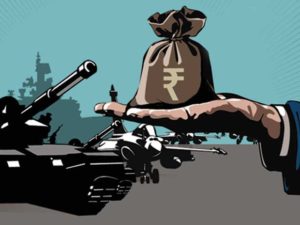
Over the past several years, unprecedented military modernization in Pakistan’s immediate neighbour, India, has worsened South Asia’s security environment. India’s heavy military spending and its unstoppable quest for the acquisition of sophisticated weapons have threatened regional stability. Indian desire to acquire global power status through military means has further been intensified as a result of US assistance, particularly in former’s defence sector. Within the quick span of time, defence trade between India and the US has shot from $1 billion to over $15 billion leaving other regional powers in the state of security consciousness.
India’s obsession with its military build-up doesn’t end here. According to the Stockholm International Peace Research Institute (SIPRI) a prestigious international institute dedicated to research into conflict, armaments, arms control and disarmament, India, once again tops the list as world’s largest weapons importer. This is not a new development as previously, India also topped the list for the same reason.
As per SIPRI estimates, Russia remains top arms supplier to India. However, surprisingly arms deliveries from the US increased more than six-fold in the five-year period to India. This trend, in the long run, will reduce market space for Russian arms and ammunition to India.
Despite the fact that, India’s unbridled military modernization is the primary impetus behind South Asian instability, global power’s economic expediencies in South Asia also undermines delicate conventional parity between India and Pakistan. For instance, Indo-US strategic partnership, which apparently touted as US’ China containment policy, seems more of a Pakistan containment policy. Much of the US provided weapon-tech to India is more useful against Pakistan in conventional warfare. Almost 70% of Indian military troops and weapon system are deployed in Line of Control, (LOC). Interestingly, peaceful settlement of Doklam issue between China and India as well as sky-rocketing bilateral trade between both countries, which has reached to $84.44 billion last year, makes prospects of conflict almost impossible.
However, in contrast to facts above, the influx of massive military hardware from western capitals to India continues, and in certain cases, the flow of arms has gained momentum. There are two primary motives behind India’s overwhelming spending in the defence industry.
First, India aspires to a greater role in the global environment, and in certain ways, it has been demonstrating its will and capability to influence global dynamics. India’s successful test of Agni-5, a long-range ballistic missile, capable of carrying nuclear weapons with a strike range of more than 3,000 miles, is a practical demonstration of its military capabilities to influence other powers around the globe. For hawkish policymakers in New Delhi, strong military power can extend India’s global influence.
Secondly, India is following a policy of coercion at regional level primarily, against Pakistan which shares the history of hostility and violence due to longstanding territorial disputes such as Kashmir. There is growing perception in New Delhi that militarily strong India can dictate South Asian affairs. That’s why India has been consistently opposing diplomacy and dialogue for peaceful resolution of disputes. Therefore, to meet its foreign policy goals, which are based on coercion and usage of hard power, India spends massive in the military build-up.
Ironically, South Asia is called as nuclear flashpoint due to the history of hatred and violent conflicts between India and Pakistan. With its mighty military power, India has emerged as the most potent threat for not just Pakistan but also a security challenge for other powers in the region.
Given the advantage it has regarding nuclear missiles, military hardware and submarine fleet, India has been trying to create an environment conducive to limited war against Pakistan. For that, India has not just developed its military doctrine, Cold Start Doctrine, but also initiated and sponsored conventional sub war in Pakistan’s chaotic province, Balochistan.
In such circumstances, Pakistan needs to maintain delicate conventional military balance vis-à-vis India. Despite the fact, Pakistan has been facing some issues at national, regional and international levels which include on-going military operation in tribal areas to hostile border skirmishes; a robust military modernization plan has become inevitable. A militarily strong Pakistan will be able to maintain its territorial integrity against aggressive yet militarily mighty India.
It’s an open fact that Pakistan has consistently called for peaceful resolution of all outstanding disputes and it has offered to resume diplomacy and dialogue over Kashmir dispute. Unfortunately, India’s cold response has not only restricted Pakistan’s peaceful overtures but also refused to accept third-party mediation in peaceful settlement of Kashmir issue. This shows that current ruling regime in India is not serious for a peaceful settlement, rather more inclined to use of force and coercion. Under such circumstances, Pakistan needs to strengthen its force posture to pre-empt any misadventure from its adversary. However, Pakistan, as it has done in the past, must embrace peaceful overtures to bring stability in the region.
